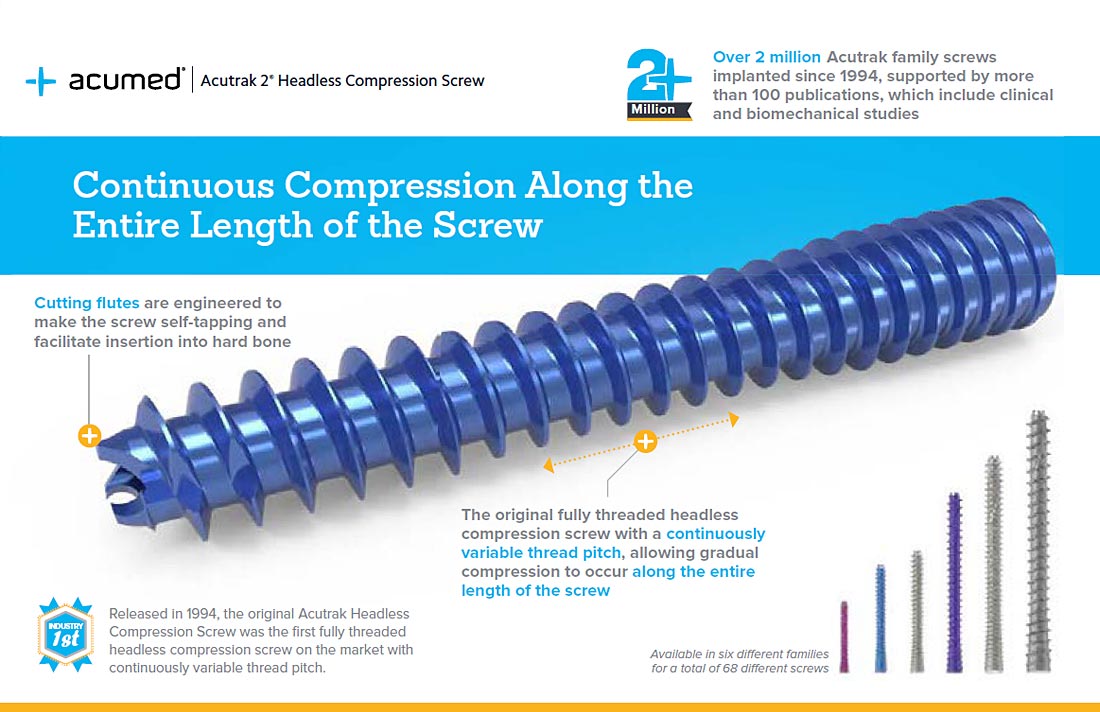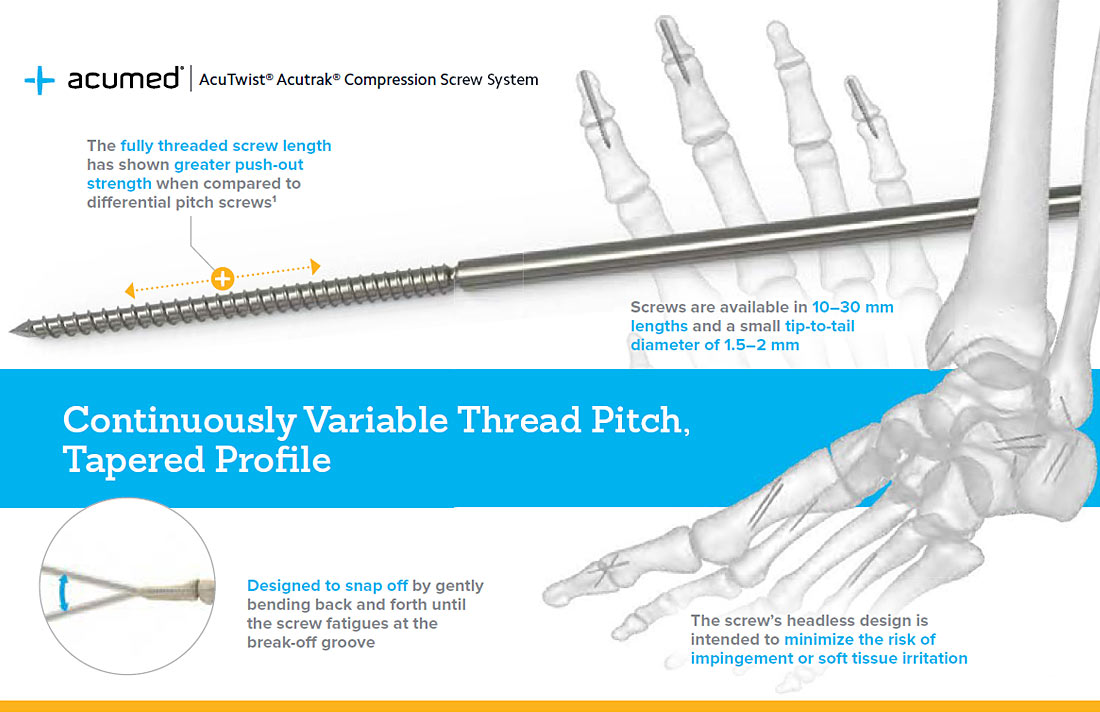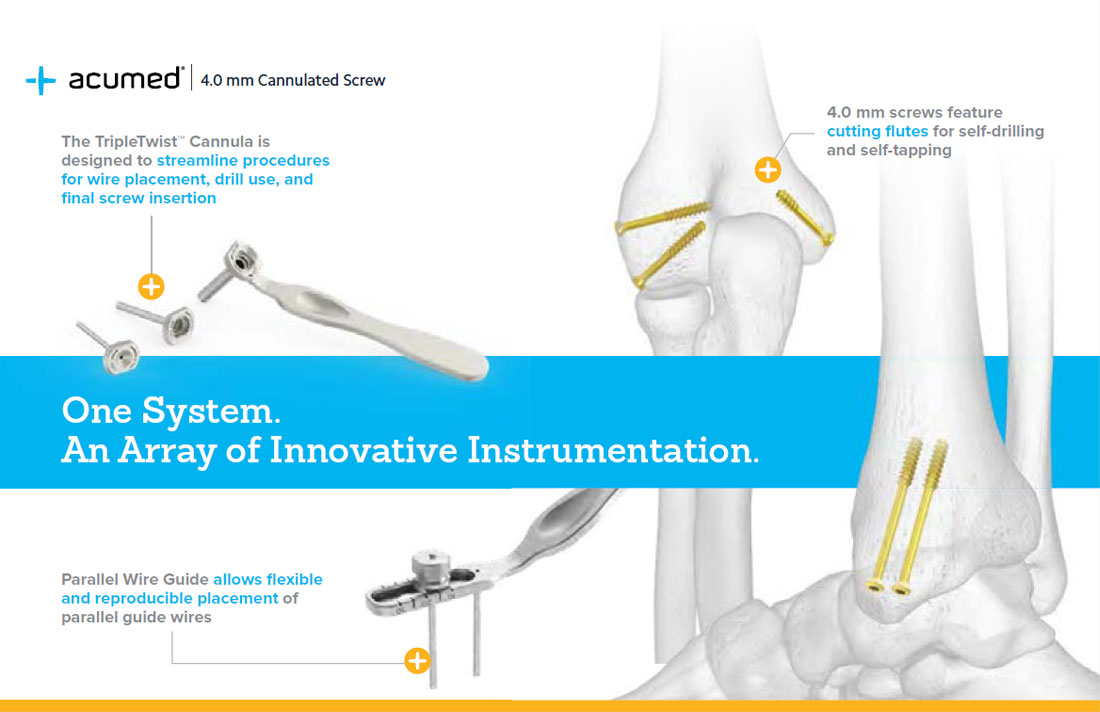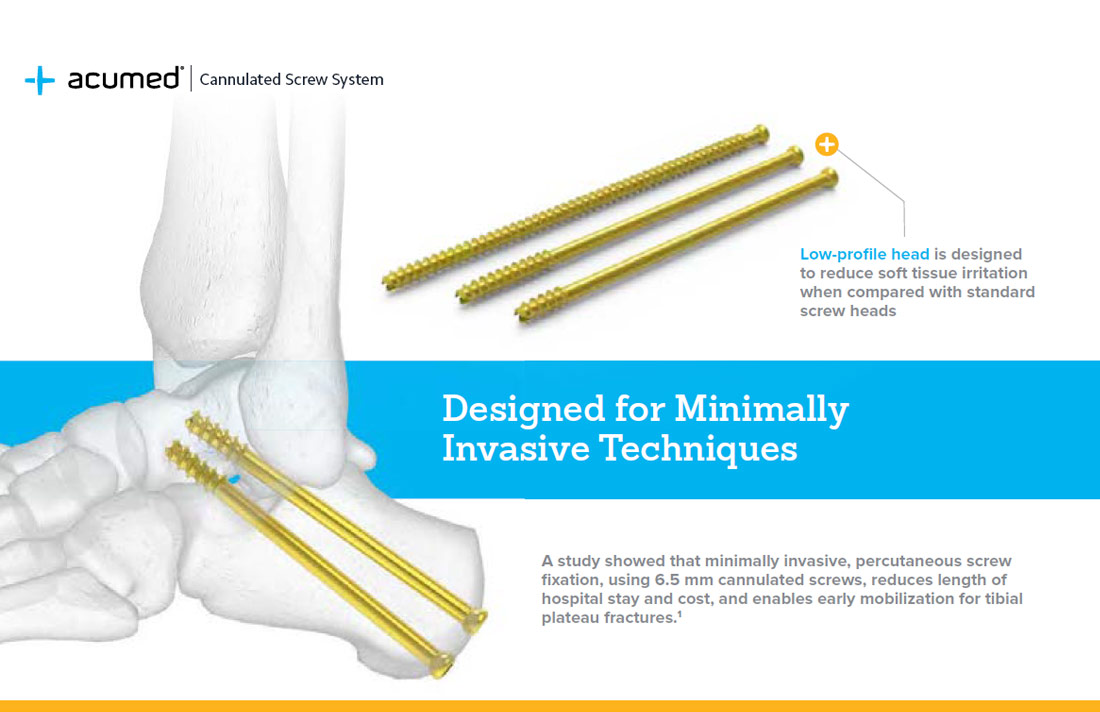Messaging Guide
Acutrak 2® Headless Compression Screw
Evidence
Why This Matters
All bone screw technologies have a “window of compression” that determines the number of screw rotations needed to reach a maximum compressive force. Evidence in this study shows traditional bone screws have a narrow window of compression. Acutrak technology has a wide window of compression that is less sensitive to loss of compression due to stripping the bone and is more flexible in its placement depth, enabling a maximum amount of compression.
Publication Excerpt
“The Acutrak variable pitch, tapered, headless, compression screw performed significantly better than did the Herbert compression screw and often better than did the AO lag screw. These ex vivo biomechanical results indicate the Acutrak compression screw may perform better than other screws under dynamic loading conditions.”
Continuously Variable Thread Pitch
The Acutrak fully threaded continuously variable thread pitch screw design provides greater compression and a larger window of compression as compared to partially threaded Herbert-style screw designs.1 In addition, this feature allows a fracture or osteotomy site to lie almost anywhere along the length of the screw.
A Family of Options
Available in six different families for a total of 68 different screws, addressing applications throughout the upper and lower extremities.
A Heritage of Healing
Over 1.5 million Acutrak family screws implanted since 1994, supported by more than 100 publications, which include clinical and biomechanical studies.
Fully Threaded
Biomechanical studies have shown that fully threaded screws better handle cyclic loading compared to AO and Herbert screws in cadaveric and synthetic bone material.1 The Acutrak Headless Compression Screw technology has shown greater push-out strength and greater resistance to torsional loading when compared with differential pitch screw technology.1

AcuTwist® Acutrak® Compression Screw System
Evidence
Why This Matters
Headless compression screws offer many benefits for DIP and IP joint fusions compared to K-wire and bone screw fixation, avoiding pin tract infection and prominent screw heads. This study suggests that the AcuTwist screws share the advantages of headless screws while being less prone to complications associated with traditional K-wire fixation.
Publication Excerpt
“Distal digital joint arthrodesis with the AcuTwist resulted in a fusion rate of 94% with a complication rate of 9%. Our rate of fusion compares favorably with prior series using other methods of fixation.”
Continuously Variable Thread Pitch and Tapered Profile
The fully threaded and continuously variable pitch and tapered profile are intended to work together to compress bone fragments into one rigid structure to help promote union.
Break-off Groove
Designed to snap off by gently bending back and forth until the screw fatigues at the break-off groove.
Fully Threaded Screw Length
The fully threaded screw length has shown greater push-out strength when compared to dierential pitch screws.1
A Range of Screw Length Offerings
AcuTwist screws are available in a range of lengths (10–30 mm in 2 mm increments) and in a small tip-to-tail diameter of 1.5 mm to 2 mm.
Headless Design
The screw’s headless design is intended to minimize the risk of impingement or soft tissue irritation.

4.0 mm Cannulated Screw
Evidence
Why This Matters
4.0 mm cannulated screws have long been a standard of care for medial malleolar fractures. A minimally invasive, percutaneous approach may be an effective surgical option. In this study, ORIF and closed reduction and percutaneous fixation (CRPF) were compared retrospectively.
Publication Excerpt
“CRPF (closed reduction and percutaneous fixation) may be a reasonable choice for patients with simple MM (medial malleolar) fracture patterns in the setting of tenuous soft tissues.”
TripleTwist™ Cannula
This modular locking cannula system is designed to protect the soft tissues and support a minimally invasive procedure. The cannulas can be used singularly or sequentially for flexibility.
Adjustable Parallel Wire Guide
Allows placement of two parallel wires. The drop-in cannula can be assembled after initial wire placement, and then adjusted to select the optimal distance between wires and ultimately screw fixation.
Implantation and Reduction Instruments
Unlike most of our competitors we offer an array of implantation and reduction instruments that can be used in applications throughout the body.
Locking Flip-Up Caddy
Unique to our system, the flip-up caddy locks in an upright position for stability on the back table.
Innovative Design Features
The system includes several instruments designed to streamline surgery. Select instruments feature laser markings for use with the triple-cannula system. And the shorter length countersink is designed to improve control compared with longer competitor devices.

Cannulated Screw System
Evidence
Why This Matters
Where clinically appropriate, minimally invasive, closed reduction, and internal fracture fixation can avoid the surgical complications associated with ORIF. This study found that percutaneous screw fixation for Schatzker type I, II, and IV fractures is an excellent treatment alternative to ORIF or conservative management.
Publication Excerpt
“Percutaneous cancellous screw fixation for closed tibial plateau fractures is minimally invasive, hence less morbid than ORIF. It reduces hospital stay and cost. It enables early mobilization with minimal instrumentation, and achieves satisfactory outcomes without any anatomical deformity or functional impairment as often seen with conservative management.”
Designed for Minimally Invasive Techniques
A study showed that minimally invasive, percutaneous screw fixation, using 6.5 mm cannulated screws, reduces length of hospital stay and cost, and enables early mobilization for tibial plateau fractures.1
A Traditional Approach to Fracture Management
The rising cost of health care and bundled payment systems are driving the use of low-cost options like cannulated screws. In nondisplaced fractures, screws may provide equal clinical outcomes over higher-cost options.
Low-Profile Head
Designed to reduce soft tissue irritation when compared with standard screw heads.
